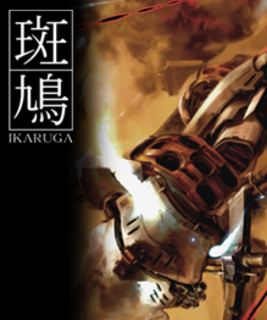Breathtaking visuals, a beautiful soundtrack and original gameplay mechanics make Ikaruga a must-play for Shmup fans.
While narrative clearly wasn't the main focal point of the game during the development phase, Ikaruga does feature an interesting backstory that gives appropriate context to the characters' actions. Tenro Horai; the leader of a small nation known as Horai; came across the Ubusunagami Okinokai or 'Power of the Gods', affording her powers surpassing that of any normal human being. With 'The Divine Ones' at her side, Tenro launched a campaign of global conquest. As the Horai felled each nation one by one, a small group of those brave enough to defy the Horai emerged, called the Tenkaku. Using advanced fighter aircraft known as 'Hitekkai', they fought a desperate battle against the Horai, but ultimately proved to be no match for their adversaries and suffered a swift and humiliating defeat. Once thought to have been among the many victims of the Horai's conquest, a young man called Shinra who had fought for the Tenkaku was shot down in an aerial battle high above the clouds. Dragged from the wreckage of his fighter and taken to the village of Ikaruga, Shinra was nursed back to health and entrusted by the village people with a powerful fighter unlike any other – the Ikaruga. Using the energies of two polarities, the Ikaruga was a versatile aircraft that could adapt to any given situation. With the power of the Ikaruga at his side, Shinra once again took to the skies to battle the Horai and bring about an end to their tyranny.
Ikaruga's most prominent feature; and indeed that which sets it apart from almost every other Shmup to date; is its Polarity system. Enemies appear in three varieties, each corresponding to one or both 'Polarities'. White enemies fire white bullets towards the player, while Black enemies discharge black bullets. Each boss typically utilizes both Polarities and is capable of executing attacks using bullets of either. The Ikaruga itself however, is capable of switching between both Polarities mid-flight, on the fly, thus introducing one of the game's most important mechanics – alternating Polarities. While using the White Polarity, the Ikaruga fires white bullets and is unaffected by those of that Polarity fired by the enemy, though direct contact with black bullets is fatal. Any Black enemies hit whilst using the White Polarity also suffer significantly greater damage than what they would have suffered, had the Black Polarity been active. White bullets that draw near the Ikaruga are absorbed and converted into energy used to fuel a powerful homing missile attack. The reverse applies when using the Black Polarity.
This clever mechanic encourages a 'risk versus reward' style of play that; together with the game's high level of difficulty; results in a very challenging but rewarding experience that makes Ikaruga one of Treasure's most enjoyable titles to play. The stage design itself is also particularly praiseworthy, both for its complexity and originality. While the first stage is quite easily manageable, every stage beyond it forces the player into a head-on confrontation with intricate mazes of bullets that require one to fully master the Polarity switching mechanic in order to stand even the slightest chance of reaching the Results screen. Skilled players can try to mix up their Polarities by alternating on a regular basis to maximize the damage inflicted on the enemy, a tactic that becomes particularly viable when facing off against most of Ikaruga's bosses. Stage 3's boss stands out as being one of Ikaruga's trickier bosses that requires a more subtle approach from the player, involving the use of a number of advanced Polarity switching techniques.
Destroying three enemies of the same Polarity consecutively results in a 'Chain', causing a substantial rise in the player's score. Each stage has been carefully designed in such a manner that it is possible for the very best players to complete a 'perfect' run of every stage by carrying a chain throughout the entire level, provided the enemies' attack patterns have been learnt well.
Though the game features a steep learning curve that is likely to deter players who are new to games of the genre, Ikaruga offers a fantastic experience to anyone willing to take the time and effort to master the Polarity switching mechanic.
Ikaruga's visuals are for the most part very impressive. The vast majority of finely-detailed enemies are well-animated. But what truly stands out is their unique design. Many of the enemies Ikaruga throws at the player look nothing like any enemies seen in other Bullet-Hell games. The boss of the fourth stage is one prime example of the sheer creativity poured forth into the game. Each and every background also benefits from the same level of detail seen in the enemy design, with some of the game's mechanical backgrounds being among the most memorable for that reason. The lighting effects seen throughout the outdoor environments capture an atmosphere that makes every stage as breathtaking to look at as it is to play.
Ikaruga's powerful musical score plays a major role in contributing towards the creation of a different feel for each stage. While flights through enormous enemy facilities are accompanied by Opera-style music with the subtle; yet highly effective; integration of Techno music, massive aerial battles amidst amber-tinted skies are fought to the triumphant sounds of trumpets, capturing the intensity and desperation of the fight. Each boss' defeat is followed by a loud and catastrophic explosion that sounds just as impressive as it is to behold.
Ikaruga is the finest example of an innovative Bullet-Hell game that is both a masterpiece in terms of its gameplay and art direction. Those who possess the time and dedication necessary to master Ikaruga and its original gameplay mechanics in order to experience the game to its fullest can expect to find themselves utterly absorbed by Treasure's iconic Shmup for a long time to come.

